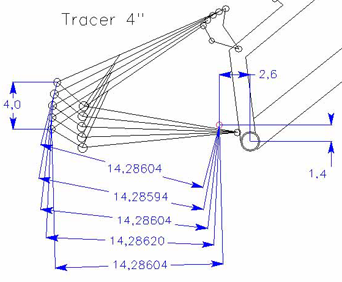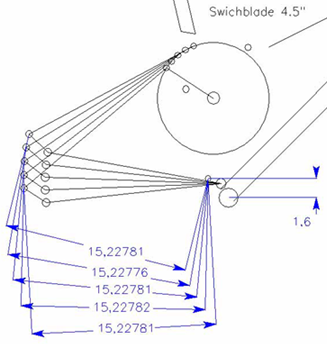
The Specialized FSR

The Intense Tracer:

The Titus Switchblade

The Turner XCE
Theory, text, illustrations, and editing by Ken Sasaki
4-bar path analysis by Peter Ejvinsson
Spanish Version translated by Antonio Osuna
Additional translation and edition for the web y José Rubio
“Linkage” suspension simulation by Gergely Kovacs
© Kenneth M. Sasaki 2001, all rights reserved
{The authors welcome the reposting or reprinting of this page or any part of it, so long as full credit is given to the authors.}
Read these sections.
They are not technically difficult and demonstrate how most of the major 4-bar designs will perform relative to one another under power.
The following CAD analyses of various 4-bar rear axle paths were done by Peter Ejvinsson. These analyses show the distances of the various rear axles from fixed points as the suspensions go through their travels. Note that with the exception of the Virtual Pivot Point (VPP), these distances are remarkably constant – that is, the wheel paths are almost circular within the range of motion. We thus say that these axles have “virtual pivots”. Note that other points on the rear links will have other virtual pivots, or none at all.
This means that, with the noted exception, the following suspensions could be paired extremely well with mono-pivots (a “split-pivot mono” would be needed in some cases), in natural mirror bikes, and will behave almost exactly like mono-pivots under pedaling and non-braking shock absorption (since all non-URTs can achieve all of the really useful suspension rates).
These frames encompass the current major design configurations used in the vast majority of chain stay pivot bikes (exceptions include the Lawwill parallel-link suspensions which are even more circular, some designs with pivots closely spaced near the center of the frame such as the Schwinn Rocket 88, and the new Maverick, which we have yet to evaluate).
We have not plotted mono-pivot or seat stay pivot bikes, since their circular nature should be trivial to evaluate.
“Horst link” designs refer to frames with lower rear pivots mounted on the chain stays, forward and below the height of the rear axle.
We have not bothered to plot the Ellsworth bikes, since these will be even more circular then the designs pictured.
There has been a persistent myth circulating that chainstay pivot suspensions “isolate” forces on the rear link and thus are not affected by pedaling or braking. But as has been noted in the “‘Internal Force’ Theories.” section, this is entirely false.
Typical Horst link designs such as the ones below are all very circular and will perform identically to the analogous mono-pivots under pedaling. Under braking, the pictured suspensions will have a tendency to extend. The virtual pivots on some, such as the Tracer, are a bit farther back then is the case in any standard mono-pivots, but the virtual pivots are not within the rear wheel radius.
 |
Figure 4.1) The Specialized FSR |
 |
Figure 4.2) The Intense Tracer: |
 |
Figure 4.3) The Titus Switchblade |
 |
Figure 4.4) The Turner XCE |